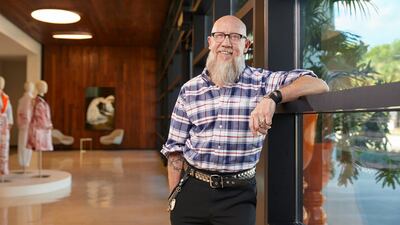
The Business of Fashion
Agenda-setting intelligence, analysis and advice for the global fashion community.

Agenda-setting intelligence, analysis and advice for the global fashion community.

SAVANNAH, United States — Over its 40-year existence, Savannah College of Art and Design (SCAD) has built a global reputation as a fashion educator.
Founded in 1978 and offering degree programmes previously unavailable in south-eastern United States, SCAD now enrols over 15,000 students from across the globe, offering degrees in over 40 majors and minors in more than 75 disciplines.
SCAD students are able to complete their studies throughout its global network of campuses, situated in Savannah, Atlanta, Hong Kong and Lacoste in France, as well as an online eLearning platform. Encouraging students to interface with different international fashion industry ecosystems, SCAD equips its graduates with global outlooks and nuanced experience. According to statistics shared by the university, SCAD enjoys a 99 percent alumni employment rate.

Michael Fink, Dean of the School of Fashion at SCAD | Source: Courtesy
BoF sits down with Michael Fink, dean of the School of Fashion at SCAD, to hear more.
How would you describe the DNA of SCAD?
Our mission statement is clear at SCAD: “We prepare talented students for creative careers.” As a result, I see our job as tutors to supply the data and knowledge that will enable students to be successful. We help lay this groundwork, not only in our mission but in the environment that we provide our students and how we operate our classrooms as professional workplace environments.
I think it’s important students understand that the skills they learn here will be implemented immediately in their careers. You have to be ready to present your pitch at any time; you have to know how to greet guests and how to present yourself overall. Once you graduate, there’s little time to learn how you’re supposed to act in a professional environment.
What are the advantages of studying internationally at SCAD?
The key advantage of international study is the opportunity to broaden your base of knowledge and your skillset by being surrounded by new opportunities. All of our students receive the same programme, regardless of which SCAD location they're attending, so this gives them a different context for how they’re going to interpret and apply their learning. It helps students to become more versatile; the more exposure you have to other cultures and other ways of doing things, the better prepared you’ll be for the workplace. Fashion is global now — there’s no one centre of the industry — so we have to be globally informed and prepare our students for employment anywhere in the world.
At SCAD, our average class size is 15 students, which speaks to the individual attention students receive. Our students also learn from experienced professionals from the fashion industry rather than career academics, with SCAD's fashion faculty having experience at Alexander McQueen, Vivienne Westwood, Calvin Klein, Ermenegildo Zegna, Donna Karan and more. This gives our students a competitive advantage once they graduate.
How do you actively turn this exposure into actionable insights?
We have a programme called SCADpro, which allows students who work in multi-disciplinary groups, not just fashion, to solve problems for companies like L’Oréal, Coca-Cola and Google, to name just a few. These companies propose projects to our students, who then help to solve real-life problems — it’s a fantastic proving ground.
Fundamentally, it's about constant evolution: education is not stagnant.
For L’Oréal, we were tasked with rethinking their Urban Decay brand. They wanted to boost in-store footfall, so the students created a number of concepts for how they could reorganise their stores, as well as strategies for re-engaging their online customers to run alongside these concepts.
I see similar approaches when we look at sustainability or diversity. For this new generation of students, these are not secondary considerations — they’re living them every day. Questions around these topics are built into their thinking, it’s not second nature. We’re helping our students apply this thinking to the real world. The question is, why is it taking so long for our industry to take the necessary action?
How much contact time do students have with industry mentors?
We host a huge variety of events at SCAD to enable students and industry to come together. We have a week every spring called SCADstyle, where design industry professionals come in and give panel discussions and then work with the students one-on-one or in small groups, again addressing current problems in the industry. These professionals also give advice on constructing portfolios in reviews and workshops. We also host annual fashion shows at our locations in Savannah and Atlanta, where students showcase their talents to key industry leaders.
We have many industry mentors who work with each of the fashion schools every year, giving advice about what they wish they’d done at university and what they wish they’d paid more attention to, as well as sharing insight into their career growth and how they got to where they are today.
The more exposure you have to other cultures and ways of doing things, the better prepared you'll be for the workplace.
We have design alumni who come in specifically to help fashion design students with their final collections, sharing the tricks of the trade and professional insights that are needed to further elevate their products. For the students, and indeed the alumni, it’s an important part of growing and forming a community — and at any SCAD location, there is something going on practically every night where students can interact with professionals.
What is the future of fashion education?
From a design perspective, it’s about constantly finding that balance between the hand and the computer. We believe our students need to have both of those skills to be successful in the industry. We don’t want analogue skills to be left behind because they are the foundations of what we do.
It’s also about continually taking data, processing it, developing our programmes, and crucially, aiming our focus not solely on fashion but on the bigger picture. Fundamentally, it’s about constant evolution: education is not stagnant, period. We have to keep moving forwards — what we did is not applicable tomorrow, especially in the fashion industry.
This is a sponsored feature paid for by SCAD as part of a BoF Education partnership. To learn more about SCAD, please click here.
From analysis of the global fashion and beauty industries to career and personal advice, BoF’s founder and CEO, Imran Amed, will be answering your questions on Sunday, February 18, 2024 during London Fashion Week.
The State of Fashion 2024 breaks down the 10 themes that will define the industry in the year ahead.
Imran Amed reviews the most important fashion stories of the year and shares his predictions on what this means for the industry in 2024.
After three days of inspiring talks, guests closed out BoF’s gathering for big thinkers with a black tie gala followed by an intimate performance from Rita Ora — guest starring Billy Porter.